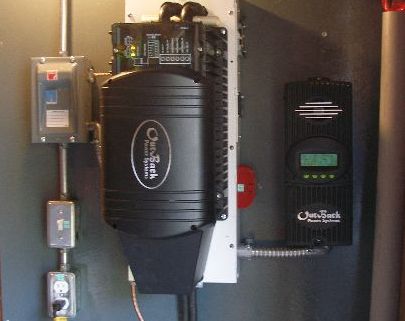Categories: Featured Articles » Autonomous power supply
Number of views: 23259
Comments on the article: 3
Inverter: sine wave or modified sine wave?
One of the indispensable devices of the backup power supply system of your home is inverter. This device is designed to convert direct current from batteries to alternating voltage of 220 V with a frequency of 50 Hz, that is, it provides similar power supply to electrical appliances in your home. Along the way, the inverter can solve additional problems. Such as, for example, load shedding during critical discharge of batteries. There are inverters that include a charge controller.

Please note that this device is required for backup power supply, as The main power is supplied by a network voltage of 220 V AC with a frequency of 50 Hz. Since backup power supply is necessary when the main power is turned off, it must provide the same parameters as the mains one.
In the case of autonomous power supply, the inverter may or may not be used. It depends on your choice of power plan. If you use ordinary household appliances in the house, the power of which is designed for voltage of 220 V AC, then you need an inverter. Some are supporters of the use of electrical appliances powered by 12 V, then they do without an inverter. In both cases, there are advantages and disadvantages.
When choosing an inverter, first of all, you need to decide what kind of load is in your house. The fact is that inverters can be conditionally divided into two types.
The first is sine wave inverters, which provide a sinusoidal voltage waveform at the output. The inverter, the so-called inverter with a pure sine wave, will provide power to any of your household appliances. Its voltage form is no different from the voltage form of a centralized network.
The second one is inverters that have a quasisinusoid (like a sinusoid) or a modified sinusoid at the output. And these inverters must be used with caution. They can be operated when there are no devices with transformer inputs among consumers, electric motors and other devices representing the inductive nature of the load.
What does this threaten? It threatens with premature failure of your household appliances, as when feeding them with a non-sinusoidal current, at best, power loss occurs, and in the worst case, overheating. With electronic devices that monitor voltage quality, this can lead to failures.
What is the problem? Take the inverter of the first type and do not rack your brains. The problem is the difference in their value. Sine wave inverters are 2 times more expensive sometimes 2.5 times. Therefore, it makes sense to deal with your consumers before choosing an inverter.
Boris Tsupilo
See also at i.electricianexp.com
:
